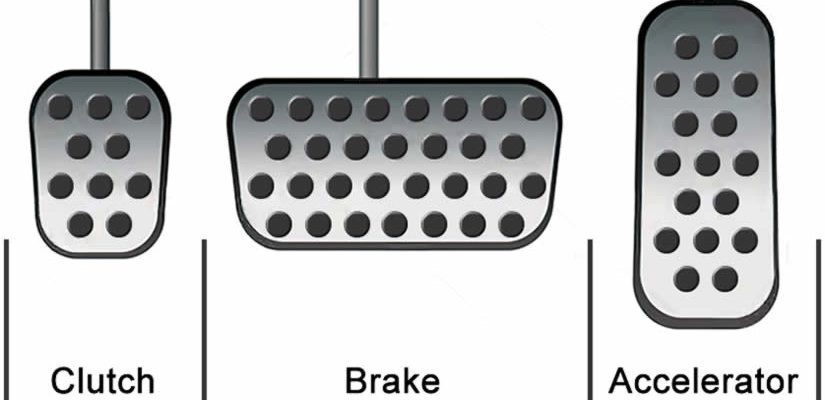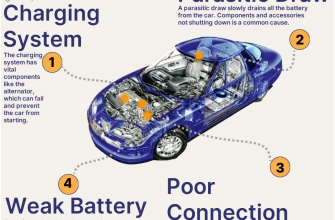When it comes to driving, the layout of a vehicle’s controls plays a crucial role in ensuring safety and comfort․ Among the most significant elements are the gas and brake pedals, which are essential for controlling speed and stopping․ Understanding their locations can enhance the driving experience, especially for new drivers or those transitioning between different vehicle types․ This article will delve into the typical locations of gas and brake pedals in various vehicles, their importance, and how they can affect driving performance․
The Standard Layout
In most vehicles, particularly those with automatic transmissions, the pedal layout follows a standard configuration:
- Gas Pedal: Usually located on the right side of the footwell, it is operated by pressing down with the right foot to accelerate․
- Brake Pedal: Positioned to the left of the gas pedal, it is used to decelerate or stop the vehicle․
This standard arrangement is designed to facilitate a natural driving motion, allowing drivers to easily switch between accelerating and braking without needing to adjust their foot position significantly․
Variations in Pedal Placement
While the standard layout is prevalent, variations do exist, particularly between different types of vehicles:
Manual Transmission Vehicles
In manual transmission cars, a third pedal is added:
- Clutch Pedal: Located to the left of the brake pedal, this pedal is used to disengage the engine from the wheels when changing gears․
The presence of the clutch pedal requires additional coordination, as drivers must learn to operate all three pedals smoothly to ensure a seamless driving experience․
Different Vehicle Types
Different types of vehicles may also have variations in pedal placement:
- Sports Cars: In high-performance vehicles, pedals may be positioned closer together to enable faster footwork during racing conditions․
- Trucks and SUVs: These vehicles often have larger footwells, which may affect the spacing and size of the pedals, catering to larger footwear․
- Electric Vehicles (EVs): While maintaining the standard layout, some EVs may have unique pedal designs that enhance responsiveness․
The Importance of Proper Pedal Positioning
Understanding the exact location of gas and brake pedals is vital for several reasons:
- Safety: Quick and precise access to the brake pedal can prevent accidents, particularly in emergency situations․
- Comfort: A well-positioned pedal layout can reduce driver fatigue, allowing for longer and more enjoyable drives․
- Performance: For performance driving, knowing the pedal positions can help in achieving better control and responsiveness․
Tips for New Drivers
For novice drivers, familiarizing oneself with the pedal layout is essential:
- Practice: Spend time in a parked car to practice moving your foot between the pedals․
- Foot Placement: Ensure your heel is anchored to the floor to pivot your foot effectively between the gas and brake․
- Know Your Vehicle: Before driving, adjust your seat and mirrors to ensure optimal visibility and comfort․
Understanding the locations of gas and brake pedals in vehicles is crucial for safe and effective driving․ Whether you’re new to driving or transitioning to a different vehicle type, becoming familiar with pedal placement can enhance both your confidence and performance behind the wheel․ Always prioritize safety and comfort as you navigate the roads, and remember that practice makes perfect․
Adjusting to Different Pedal Configurations
As drivers explore various vehicles, they may encounter different pedal configurations that can affect their driving style․ It’s essential to adapt quickly to these variations to maintain both control and safety․ Here are some common adjustments drivers may need to make:
- Foot Positioning: In vehicles with more compact footwells, such as sports cars, drivers may need to be more precise with their foot placement․ Practicing in an open area can enhance comfort and control․
- Pressure Sensitivity: The response of gas and brake pedals can differ significantly between vehicles․ Some may require a lighter touch, while others may necessitate more pressure․ Familiarizing oneself with the sensitivity can prevent abrupt movements․
- Size and Height: Taller vehicles or those with raised suspensions may have pedals that feel farther away, requiring drivers to adjust their seating position for optimal reach․
The Role of Technology
Modern vehicles increasingly incorporate advanced technology that can influence how gas and brake pedals operate:
- Adaptive Cruise Control: Many new cars come equipped with adaptive systems that can automatically adjust speed and braking․ Understanding how these systems interact with traditional pedals can enhance driver confidence and safety․
- Electronic Throttle Control: Instead of traditional cables, some vehicles feature electronic throttle systems that can alter how gas pedals respond․ Drivers may notice differences in feedback and responsiveness․
- Regenerative Braking: In electric and hybrid vehicles, regenerative braking systems can change how the brake pedal feels and operates, often allowing for smoother deceleration․
Pedal Placement for Accessibility
For drivers with disabilities or physical limitations, proper pedal placement can be crucial․ Adaptive technologies and modifications can help ensure safe driving:
- Hand Controls: For individuals who cannot use foot pedals, hand controls can be installed to allow for acceleration and braking using hand-operated levers․
- Pedal Extensions: Pedal extensions can help shorter drivers reach the pedals comfortably, enhancing their control over the vehicle․
- Custom Configurations: Some vehicles can be modified to accommodate specific needs, allowing for a more personalized and safe driving experience․
Mastering the locations and functions of gas and brake pedals is a fundamental aspect of becoming a proficient driver․ By understanding the standard layouts, adapting to variations, and utilizing modern technologies, drivers can enhance their skills behind the wheel․ Whether navigating city streets or cruising on the highway, knowing how to efficiently operate the gas and brake pedals can make all the difference in achieving a smooth and safe driving experience․ Ultimately, practice and awareness are key—so get behind the wheel and start mastering those pedals!










This article provides a clear and concise explanation of the importance of gas and brake pedal placement. It’s especially helpful for new drivers!
I found this article very useful. The explanation of how pedal placement affects driving performance is spot on!
An excellent read for anyone transitioning between vehicle types. The details about sports cars and trucks were particularly interesting.
I love how the article breaks down the standard layout versus variations in different vehicles. It really helps to understand what to expect!
Great insights on manual transmission vehicles! I appreciate the emphasis on coordination with the clutch pedal. Very informative!
This article is a must-read for new drivers! Understanding pedal placement can truly enhance driving safety and comfort.